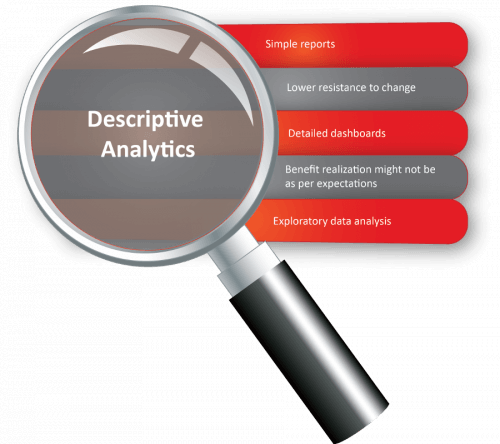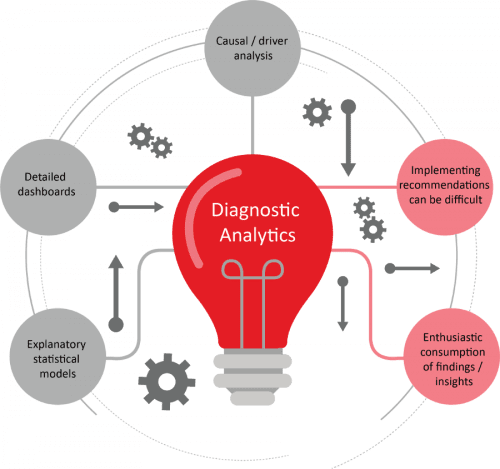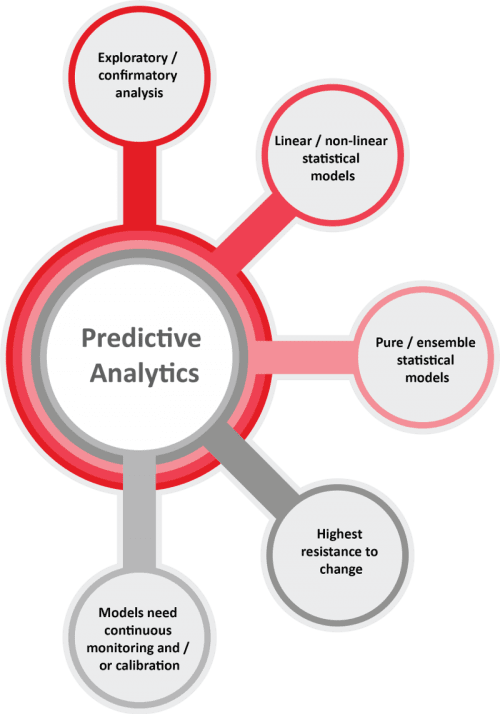Demystifying the current analytics scenario
With the emergence of technological innovation, data analytics services have continuously evolved over the last decade. The scope ranges from simple BI reports to detailed and customized dashboards, to predictive modeling solutions. The scale and infrastructure of data analytics have also evolved with a growing demand for synthesized solutions. Enterprises have witnessed exponential data growth, which has foreshadowed the arrival of big data technologies like Hadoop and Apache Spark.
It all begins with a dataset! With soaring levels of data, analytics is gaining prominence in the business space. According to a research conducted by Computer Associates, 55% of all companies with over USD 500 million in yearly revenue have executed big data projects in the recent past. The remaining companies have expressed their desire to embark on the same ‘big data’ path over the next three years. The ability to transform raw data into meaningful information enables business users to take accurate and fast decisions. Thus, sophisticated analytics has become a ‘must-have’ for companies in their pursuit of staying competitive.
While this survey from Computer Associates presents the incredible achievements of top Fortune companies, there is a gray side to it as well. Why aren’t the medium and small scale businesses able to derive enough value by implementing data analytics? What is it that has restricted these small businesses to succeed in implementing data analytics solutions? A deeper look by our data analytics experts and business consultants has shown that the real challenges remain behind the scenes. Based on their diverse working relationships with clients, we have observed two main challenges in adoption of analytics:
Type I: Implementing analytical solutions or recommendations
Type II: Realizing benefits from implemented analytical solutions or recommendations
Different types of analytics projects and their challenges
On the base, it was found that challenges emerged when businesses started neglecting the transformations in existing processes, systems, and practices. Based on the pattern of analytics operations, the level of resistance varies. Let us take a close look at the three most prominent types:
1. Descriptive analytics projects:
These types of projects involve developing graphs, charts, and dashboards, accompanied by relatively simple data analysis functions. The focus is on identifying the right set of metrics and presenting information in an effective manner.
Descriptive analytics solutions, in general, face lesser resistance challenges in its implementation. The reasons are obvious – the deliverables are well understood by clients. However, descriptive analytics projects can face Type II problems. Questions might crop up as to what is the ROI of the report implementation?
An instance:
An insurance company encountered such Type II problems as it underwent a transformational phase. There were initially innumerable reporting solutions in place based on SAS and Excel. The company decided to set up a data warehouse and change the reporting technology to Tableau. Although from a technological perspective the company succeeded in the transformation process, it was unable to realize the benefits from the redeveloped reports. This was because business users were not able to leverage Tableau’s features to make the decision processing faster in order to derive more insights. Business users made use of the Tableau reports in a manner similar to the previous Excel reports, as they were not provided adequate training on how to leverage the new technology to change their decision-making processes.

2. Diagnostic analytics projects:
The objectives of diagnostic analytics projects are to understand the reasons for a particular phenomenon and conduct a driver analysis. Diagnostic analytics projects can culminate in the development of statistical models (explanatory models, causal models, etc.) and dashboards. However, the output must include insights and recommendations, which help to understand the reasons and eventually initiate appropriate actions.
Diagnostic analytics outcomes have a slightly higher resistance to the implementation of recommendations. Business users are aware that some recommendations are not actionable due to the requirement for numerous changes and restrictions. However, they are receptive to the findings and insights, and usually show keen interest to bring about necessary changes in the business process. For instance, the company goes ahead with a pilot implementation of the new process. This pilot implementation checks how the benefits can be availed on a temporary basis before institutionalizing the same throughout the organization.

3. Predictive analytics projects:
These projects involve forecasting a certain metric or predicting a certain phenomenon. Predictive modeling is a process of applying a statistical model or data mining algorithm on data for the purpose of predicting new or future observations. Predictive models can be used not just for prediction, but also for simulation purposes. Examples include clinical research, sales prediction, production failure, weather forecasting, etc.
Predictive analytics solutions face the highest degree of resistance for obvious reasons. Diagnostic and descriptive solutions largely deal with what has already happened, while predictive solutions relate to something that is yet to happen. Thus, business users have reservations about predictive solutions. This skepticism is not baseless, as the cost of wrong predictions can be astonishing.
An instance:
A consumer durables client faced such a challenge. The objective was to create a sales forecasting model that was developed for a particular category of products. We have created a regression model with the most significant independent variable being ‘Price’. One of the stakeholders wanted to know if variations in actual prices influenced sales exactly as per the model results. This particular stakeholder was unaware of the fact that delivering exact predictions is rare, though not impossible. Predictive solutions provide an indication of the prospective future, but they cannot forecast accurately. Consequently, they should only act as a decision support system. A business user should consider using the results of predictive modeling as indications, and take decisions according to his or her discretion.

As a matter of fact, the above observations distinctly indicate the various challenges faced by some mid-sized and small scale businesses. Around the globe, several businesses have invested largely in data analytics seeing the revolutionary potential. Due to lack of proper situational analysis, these businesses had to suffer huge losses and have seen awful outcomes.
So what exactly is it that will help businesses overcome such challenges and upscale ROI? Are we really trying to find our way out of this unsolved maze? Not really! Here’s what PWC and Iron Mountain have in store to counter such issues.
Can change management streamline successful execution of data analytics?
PWC and Iron Mountain joined hands to conduct a survey among 1,800 senior business leaders from mid-sized to large organizations in North America and Europe. Using the survey data, PWC created the Information Value Index. The index ranging from 0 to 100 evaluates a company’s general awareness and understanding of the importance of data. Further, the index also considers how companies align with their data-driven goals, as well as the skills and tools that are used to gain value from data. Mid-sized companies earned an average score of 48.8 and large businesses fared slightly better at 52.6. The overall average was just above 50.
The survey showed that there is still some way to go before companies can derive competent value from the data they possess. Change management can significantly contribute to this particular objective.
In another survey, Computer Associates interviewed 1,000 IT managers across companies with more than USD 500 million in revenue in different industries such as retail, financial services, pharma, etc. The research findings revealed major obstacles in the implementation of big data projects as shown in the snapshot below:
.png)
Source: https://www.ca.com/us.html
Change management can go a long way in removing some of the obstacles as shown in the snapshot above. Let’s have a look at the following important areas:
- Difficulty to justify from the ROI standpoint (23%)
- Lack of understanding by senior management (21%)
- Risk-averse corporate culture (10%)
Change management focus areas – bringing it all together
We genuinely believe that companies can overcome challenges faced while executing analytics projects if they undertake appropriate change management initiatives. One of the famous change management models is the ADKAR model. The ADKAR model includes the following components:
- Awareness of change
- Desire to change
- Knowledge about the methodology of change
- Ability to implement the change
- Reinforcement to sustain the change
We have ranked the different types of analytics projects, in terms of different components of the ADKAR model. We have also assigned a rating of “high” to “low” based on our understanding and experiential knowledge. However, the ratings are likely to vary from one company to another depending on its own set of experiences.

The above table gives an indication of the change management requirements for successful implementation of analytics projects depending on the type of project. For example, to ensure the success of a descriptive analytics project there should be more thrust than usual on the components “Knowledge”, “Ability”, and “Reinforcement”. To ensure the success of a predictive analytics project, it requires emphasizing on the “Desire” component before looking at other factors. Unsurprisingly, descriptive analytics projects are ranked the highest in all the components, while predictive analytics projects are ranked the lowest in most of the components.
Wrapping it up
There is a general line of thought that companies should not just invest in setting up different analytical software, big data infrastructure, or training on the same. It is important to invest in change management processes and initiatives. As a result, there is a clear need for companies to set up their own internal change management team or seek external vendors. Only appropriate planning will enable companies to increase the success rate of projects, leading to better ROI and increased benefits from analytical initiatives. In order to positively influence the trajectory of businesses, a fresh look and a dynamic team are the keys to a successful execution of analytics technologies. As the cognitive age is clearly upon us, are we all set to complement one another? Let’s gear up to counter the upcoming and unseen future!
References









